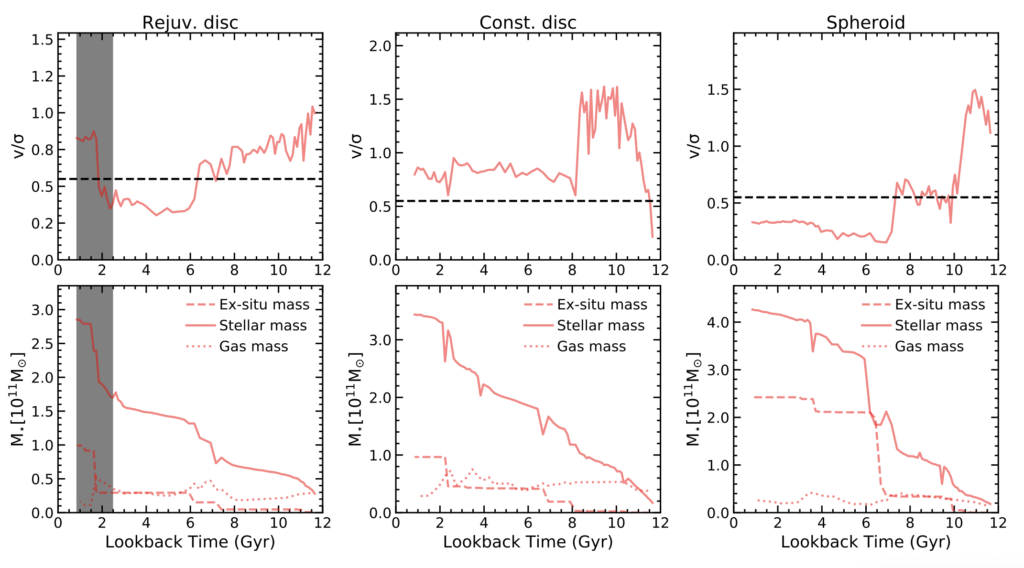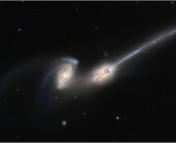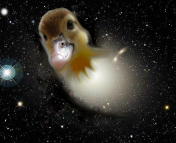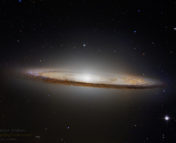Title: Why do extremely massive disc galaxies exist today?
Authors: Ryan A. Jackson, Garreth Martin, Sugata Kaviraj, Clotilde Laigle, Julien Devriendt, Yohan Dubois, Christophe Pichon
First Author’s Institution: Centre for Astrophysics Research, School of Physics, Astronomy and Mathematics, University of Hertfordshire, Hatfield, UK
Status: Accepted to the Monthly Notices of the Royal Astronomical Society, open access on arXiv
A Galaxy’s Life
One widely-held theory of how galaxies grow and evolve throughout cosmic time is a process known as hierarchical growth. In this scenario, smaller galaxies merge with each other to form larger galaxies, which explains why the most massive galaxies we see live in the local universe. There are two major types of galaxies in the Universe: spirals and ellipticals, often called disk and spheroidal galaxies. For more details on galaxy evolution check out this astrobite.
Because galaxy mergers tidally distort pairs of galaxies, stars initially on ordered orbits within the galaxies tend to be disturbed and placed on randomized orbits. This means that the most massive galaxies, which have formed through multiple major mergers, tend to be spheroidal in nature. Despite this, roughly 10 percent of galaxies more massive than ~4 times the mass of the Milky Way have significant disks. Because the number of major mergers a galaxy experiences is highly dependent on its stellar mass, it is likely that all massive galaxies have gone through a similar number of large mergers throughout cosmic time. If this is true, then why do we still see massive galaxies with disks in the local universe?

Creating a Mock Universe
In order to answer this question, the authors of this paper simulate the universe using the Horizon-AGN simulations. These simulations include both stellar and AGN feedback, which impart energy, momentum, and enriched material into the galaxy. With their simulation, the authors can trace the evolution of stars, black holes, and galaxy morphology in great detail over time. The merger histories of galaxies are traced from a redshift of z = 3 to z = 0.06 (corresponding to almost 11 billion years) in time steps of ~130 million years.
The morphology of a galaxy is in part defined by the motions of stars in the galaxy. The authors calculate the ratio of the mean rotational velocity (v) to the mean velocity dispersion () of the stars in a galaxy. High values of v/
indicate rotationally-supported systems (disks) and low values are dispersion-supported (spheroidal). By looking at galaxies in the local universe, previous literature has defined the separation between disk and spheroidal galaxies to be v/
= 0.55. The authors note that the disk galaxies studied in their paper have v/
much greater than 0.55 and therefore are robust disk galaxies. By selecting galaxies with a stellar mass greater than
and v/
> 0.55, they find 569 massive disks, or 11 percent of all the massive galaxies in their sample, which is consistent with observational studies.
How to Grow a Massive Disk Galaxy
By studying the properties of the galaxies in their simulations, the authors discover two main channels for forming massive disk galaxies. Figure 1 graphically illustrates these two channels for massive disk formation and the evolution of a spheroid. The first channel is a “rejuvenated disk” or a major merger with a gas-rich companion that happens to give the original galaxy a kick that increases its rotation. Figure 2 shows the merger histories for each of these three cases, and suggests that the merger mass ratio is often greater than 1:10 for rejuvenated disks. The second channel is the “constant disk” scenario, where disk galaxies do not experience major mergers in their lifetime, and thus never lose their disk component.

By looking at the v/ evolution for massive disks, the authors find that the rejuvenated disk channel is responsible for roughly 70% of all massive disks while the constant disk channel accounts for 30% of massive disk galaxies. In the remaining spheroids, mergers with gas-poor galaxies only serve to randomize stellar orbits and reinforce the spheroid classification. The authors find no clear explanation for the constant disk scenario besides stochastically low merger rates, thus explaining their low fraction.
Because rejuvenated disks seem to be the preferred method for creating massive disk galaxies, the authors expect to see a correlation between gas in the universe and the percentage of massive galaxies that are disks. These variables as a function of time are shown in Figure 3. The inset of the plot compares gas fraction and massive disk fraction, and we see that they are strongly correlated.

The authors find that rejuvenated disks tend to reside in less massive dark matter halos than the rest of the massive galaxy population. Their explanation is that these low density environments are less prone to ram pressure stripping and tidal processes that would tend to turn disks into spheroids. Additionally, in these environments there are more gas-rich galaxies for rejuvenating mergers to occur. The authors also find that the median redshift of the last major merger for rejuvenated disks is z ~ 0.3, as compared to z ~ 0.49 for the spheroids. This corresponds to roughly 1.5 billion years fewer for the rejuvenated disk to turn into a spheroid through minor interactions.
Regardless of the method for creating a massive disk galaxy, the authors have found robust explanations for the observed fractions of massive disk and spheroidal galaxies at low redshifts. This result serves to reinforce the theory of hierarchical growth, but shows that naive assumptions about major mergers require more detailed insight into the progenitor systems.




